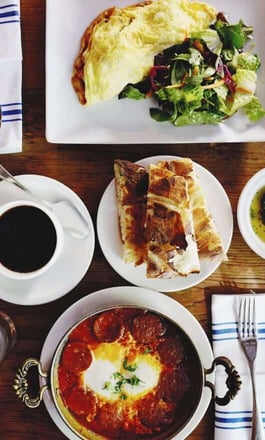How the Omelet Became a Global Dish with Many Variations
A nice fluffy omelet has long been a popular side dish since the days of Napoleon Bonaparte. Legend has it that a local innkeeper near the town of Bessieres, Haute-Garonne fixed the delicious egg concoction for the French military leader during a stop for rest. Bonaparte was immediately hooked. In fact, he ordered the townspeople to gather up all the eggs in the village in order to prepare a large omelet for his army the next day. Word spread about the dish and people across the globe even began to experiment with the original recipe, adapting it to their ingredients and tastes.
 However, one thing remained the same. To make an omelet you need eggs. Traditionally, the recipe calls for eggs that are well-beaten and cooked with butter or oil in a frying pan and filled with ingredients such as: cheese, vegetables and meat (usually ham). Sometimes, instead of whole eggs only the whites are used, adding a small amount of cream, milk or water to obtain a fluffy texture.
However, one thing remained the same. To make an omelet you need eggs. Traditionally, the recipe calls for eggs that are well-beaten and cooked with butter or oil in a frying pan and filled with ingredients such as: cheese, vegetables and meat (usually ham). Sometimes, instead of whole eggs only the whites are used, adding a small amount of cream, milk or water to obtain a fluffy texture.
The world’s first largest omelet was made using 160,000 eggs on March 19, 1994 in Yokohama, Japan. Although the average person usually enjoys having an omelet for breakfast, it is actually one side dish that deserves a place on any brunch menu. This is largely due to the variations in which it can be prepared, complimenting any breakfast or lunch item.
Throughout the centuries, cooks have gotten quite skilled and creative when it comes to making an omelet. The following omelet recipes prove why this beloved dish fits the bill when it comes to serving brunch and how it has reached kitchens all over the world.
See Bodrum Brunch’s Variety of Omelets
Egg white omelets are made with the omission of yolk, removing fat and cholesterol for those who are health conscious.
French omelets are cooked briskly using clarified butter in a special pan. It is often flavored with tomato, chervil, parsley, chives, chopped onions or tarragon with salt and pepper.
Khaginech is an Iranian omelet made with sugar and eggs beaten together then cooked quickly in a frying pan coated with butter or oil.
Nargesi (Spinach Omelet) is another Iranian version of the omelet made with spinach and fried onions and spiced with salt, pepper and garlic.Baghala ghatogh, also of Iranian origin, is made with Baghalas (Rashtian faba beans), eggs, dill and spices.
Greek omelets are pan-fried usually with sautéed vegetables.
Indian omelets (Masala) are made with lots of spices added before the eggs are whisked. The most commonly used condiments include: coriander leaf, cumin, turmeric, chopped green chilies and chopped onions.
Also popular in the Netherlands, the omelet is normally made with mushrooms, sautéed onions, potatoes, leeks, bell peppers and garden peas.
Great Britain fancies adding cheese and milk and to their eggs.
The Japanese favor adding soy sauce, bonita flakes, sugar and water to their mixture.
During the Gold Rush, an omelet recipe calling for added bacon and breaded oysters emerged from Placerville, California.
It’s plain to see how the omelet has changed since Napoleon Bonaparte took his first bite all those hundreds of years ago. Nevertheless, no matter how you like it or where you travel, there is an omelet recipe out there that is sure to please.






